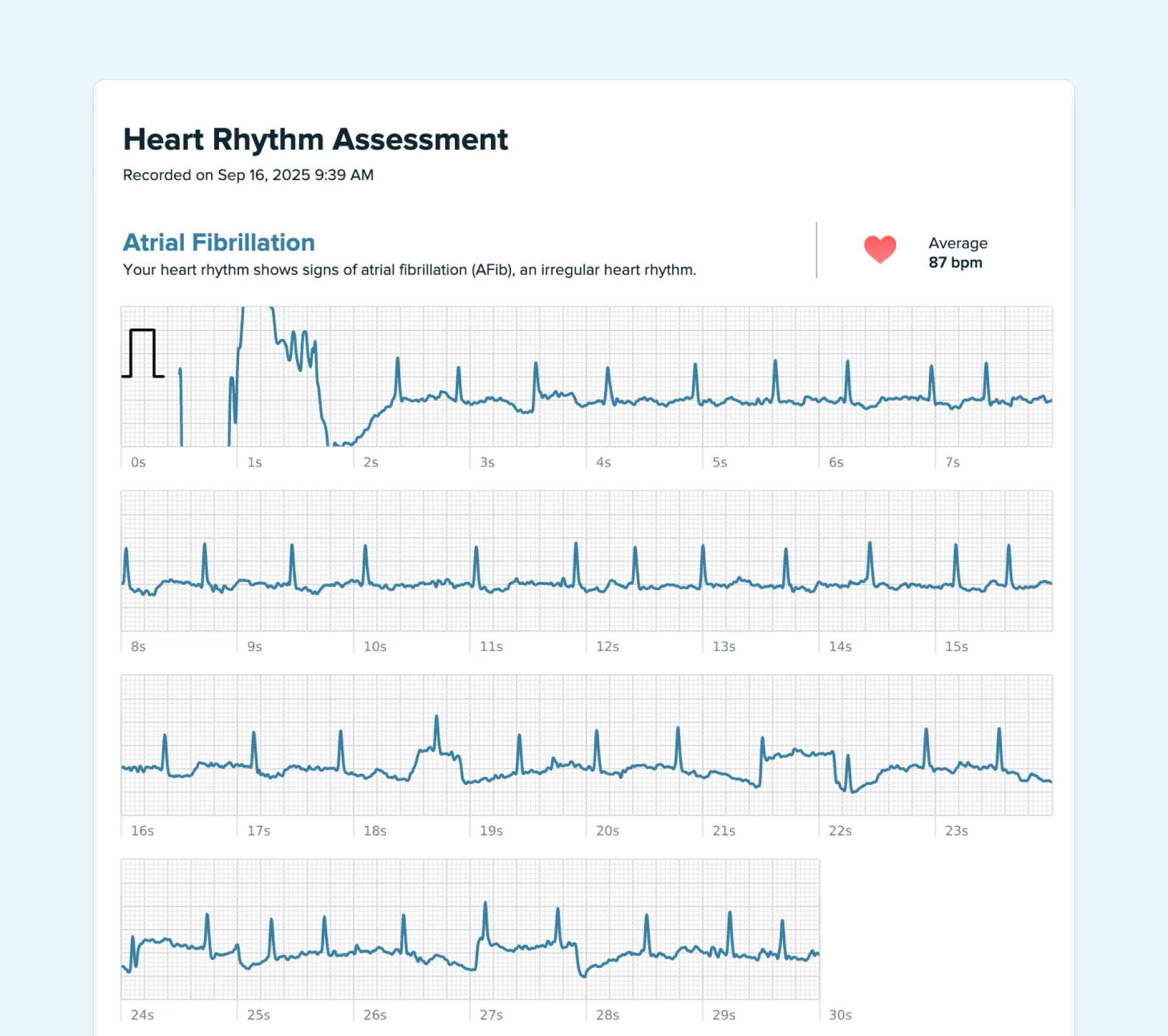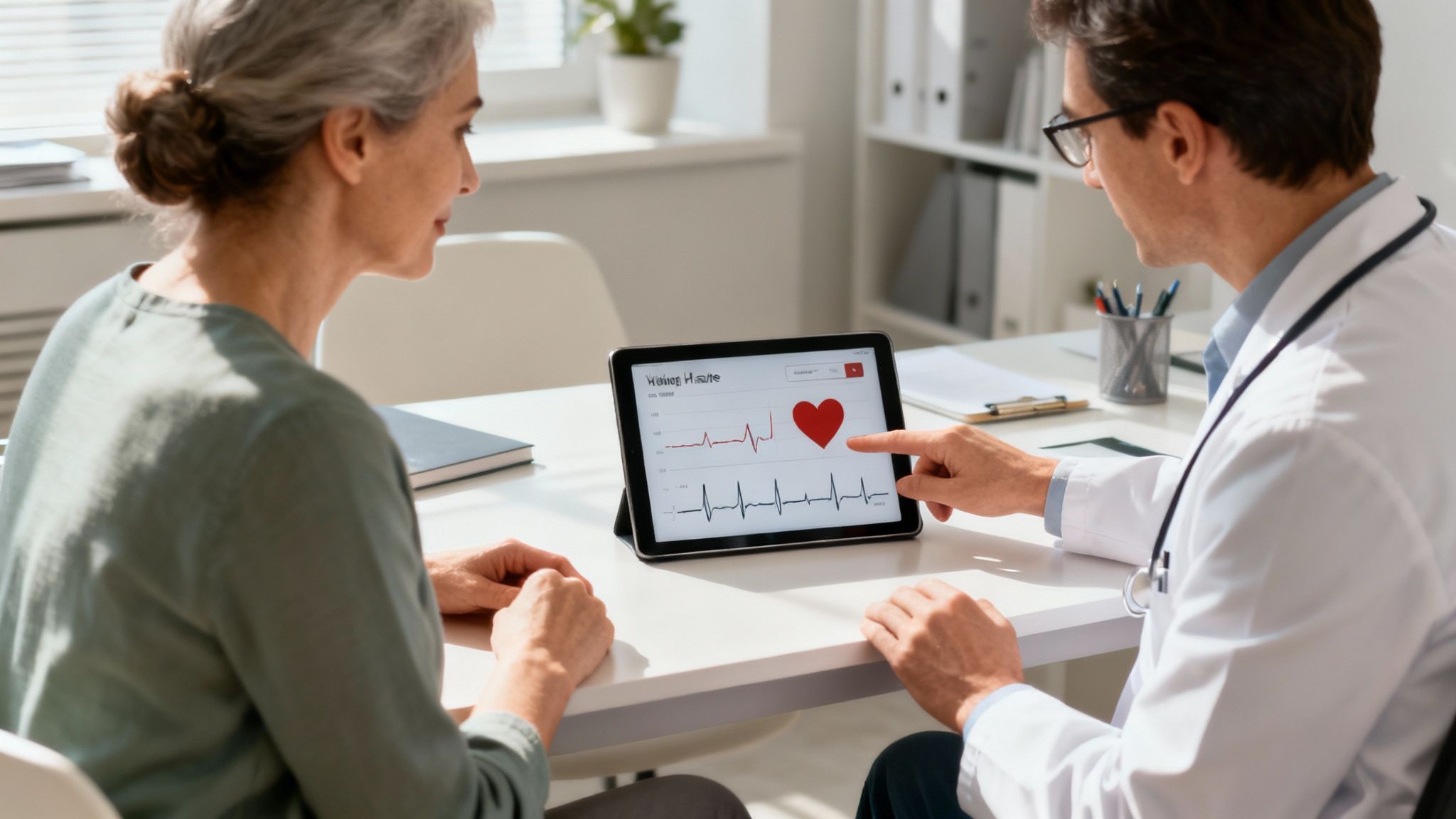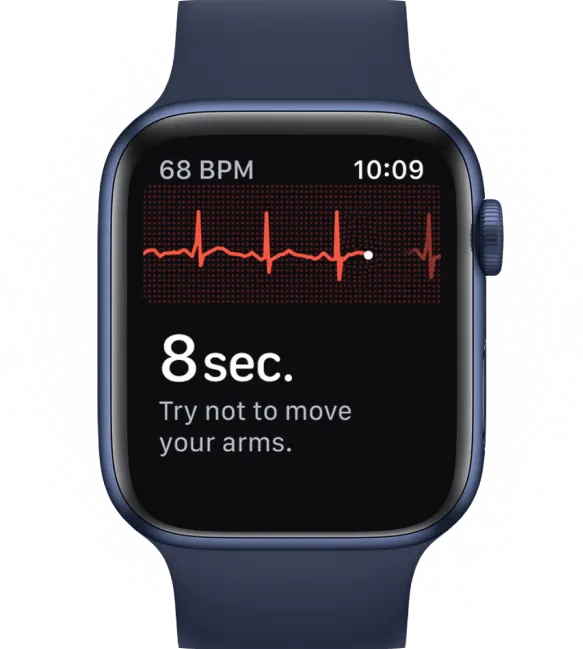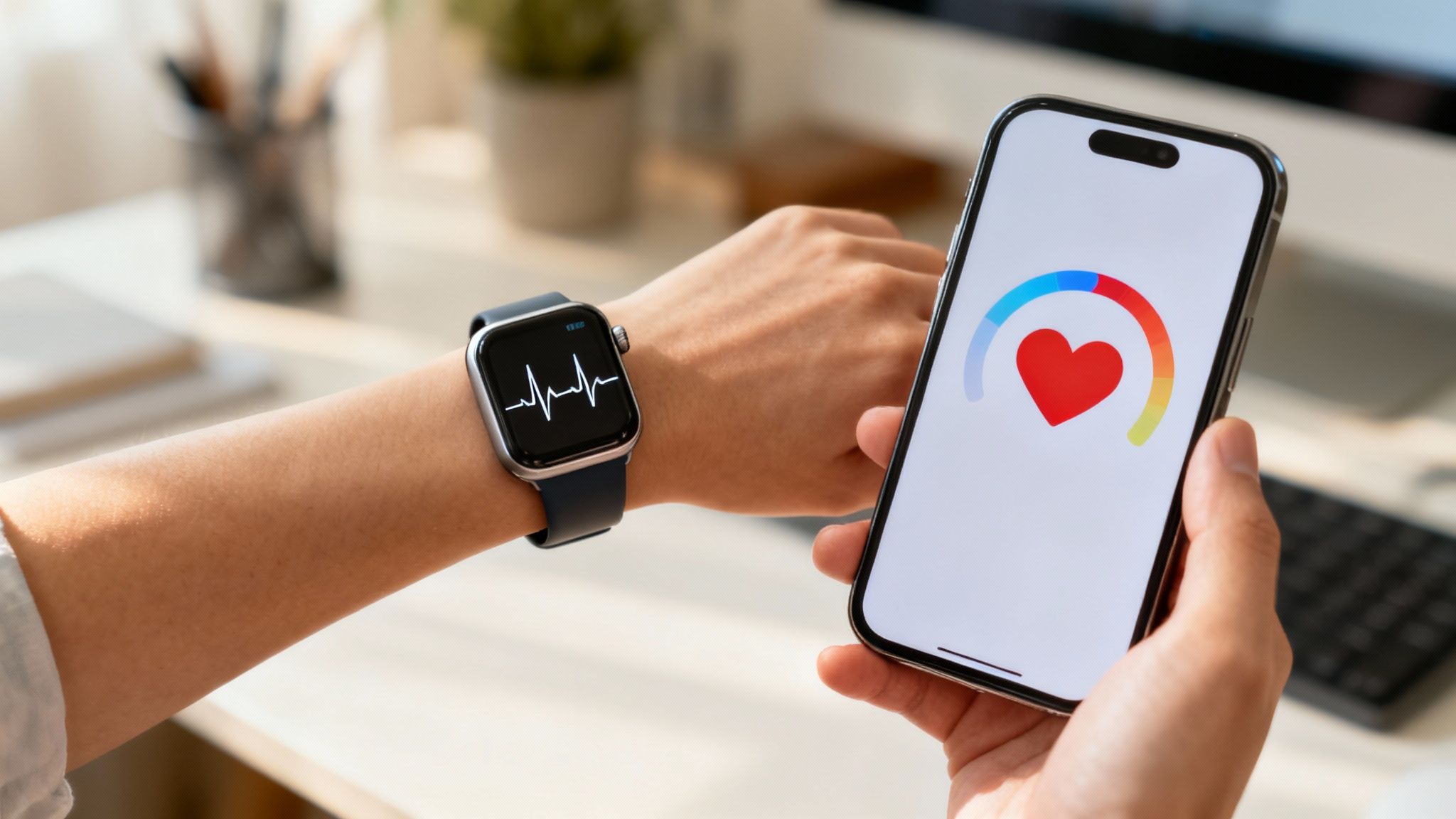Key Takeaways
Hello Heart Hero. We get it. Conversations about heart health can feel heavy, especially if you've ever felt dismissed or confused in a doctor's office. We know it can be frustrating when you feel like you're not being heard. This guide is different. We’ve designed it to be a clear, calm space to take the mystery out of the risk score for cardiovascular disease and turn it from a number you fear into a tool you can use.
Your Guide to Understanding Heart Health

Sometimes, navigating the healthcare system feels like being handed a final grade without ever seeing the test questions. A doctor might give you a number or a percentage, leaving you feeling worried, confused, or maybe even a little judged. We want to completely change that story for you.
Our goal is simple: to walk you through what these scores are, why they matter, and how they can serve as your personal roadmap, not a final destination. Think of your risk score as a key that unlocks more confident conversations with your doctor and helps you make informed choices for your future.
Why This Conversation Matters Now More Than Ever
Understanding your personal risk has never been more important. Globally, the impact of cardiovascular disease has grown to staggering levels, highlighting major gaps in health outcomes between different parts of the world. It's natural to feel skeptical about a system that seems to be struggling.
In 2022 alone, an estimated 19.8 million people died from cardiovascular diseases. That's about 32% of all global deaths. A huge 85% of these were from heart attacks and strokes, which shows just how critical preventative awareness is for everyone. You can dig deeper into these global health trends over at who.int).
This guide is all about giving you practical knowledge that puts you back in the driver's seat. We'll go through this topic together, step by step. No dense medical jargon, just straightforward guidance to help you on your path to a healthier heart.
What to Expect from This Guide
We believe knowledge is the first step toward empowerment. Instead of throwing a bunch of dry facts your way, we’re going to break down everything you need to know in a clear, supportive way. Here’s a peek at what we'll cover:
- Defining the Score: We’ll explain what a risk score for cardiovascular disease actually is, in simple terms.
- Comparing the Tools: You'll learn about the different types of risk calculators doctors use to figure out these scores.
- The Role of Wearables: We'll dive into how data from your smartwatch adds another important layer to your health story.
- Actionable Next Steps: We’ll give you practical advice on what to do with all this information.
Our promise is to provide a reassuring space where you can learn without fear. This is about transforming numbers on a page into a powerful tool for your well-being, helping you become an active partner in your own healthcare.
What Is a Cardiovascular Risk Score Anyway?
Let's start with a simple analogy. Think of your long-term health as a road trip. A risk score for cardiovascular disease is like a sophisticated GPS for your heart's journey. It doesn't just tell you your current speed; it scans the entire road ahead, looking for potential hazards and suggesting smoother routes.
It’s not some scary crystal ball predicting your future. Instead, it’s a personalized forecast that helps you and your doctor see what might be coming. This allows you both to map out the best path forward, putting you in the driver's seat.
The Ingredients of Your Heart Health Forecast
This "GPS" doesn't just guess. It uses a specific set of inputs, like ingredients in a recipe, to calculate a percentage. This number represents your statistical chance of having a major heart event, like a heart attack or stroke, within the next 10 years.
The most common ingredients in this calculation include:
- Your Age and Sex: These are the foundations, since risk naturally changes as we get older.
- Blood Pressure: Both the top number (systolic) and bottom number (diastolic) are critical pieces of the puzzle.
- Cholesterol Levels: This usually means your total cholesterol, HDL ("good") cholesterol, and sometimes non-HDL cholesterol.
- Smoking Status: A straightforward but powerful factor that heavily influences your score.
- History of Diabetes: Having diabetes is a key input for nearly all risk calculators.
These factors are plugged into a formula to give you a score. Think of it as a snapshot in time, a clear, objective starting point for a productive conversation about your health.
More Than Just Individual Numbers
Your health isn't just a collection of numbers; it's a complete picture. That's why some newer calculators are starting to add more details to bring the image into sharper focus.
For example, some might consider kidney function or even your zip code to account for socioeconomic factors that can affect health. It's also vital to understand how broader health conditions play a role. A great example is metabolic syndrome, a cluster of issues like high blood pressure and excess body fat that directly raises heart disease risk. For a deeper dive, check out this guide on what is metabolic syndrome and how to reverse it.
The real power of a risk score for cardiovascular disease isn't the number itself. It's the conversation it starts. It transforms vague worries into a concrete starting point for proactive care, helping you and your doctor build a preventative maintenance plan for your unique journey.
From a Snapshot to the Full Story
While a standard risk score is a powerful tool, it's based on information from a single moment. Sometimes, your doctor might want a more detailed look under the hood. For instance, they might order a special CT scan to measure calcium buildup in your heart's arteries. This gives another layer of highly specific information about what's actually happening inside your body. You can learn more about how this works in our guide on the calcium heart test.
Ultimately, your risk score is a guide, not a final verdict. It’s the beginning of a story, not the end. By understanding what goes into it, you gain the power to ask better questions and become an active partner in managing your own health journey.
Different Calculators, Different Results: Making Sense of It All
Stepping into the world of heart health can sometimes feel like every expert is using a different map to get to the same place. It's understandable if you're feeling a bit skeptical about which path is the right one.
You might get one result from a heart risk calculator online and a slightly different one from your doctor. It’s a lot like how one weather app predicts a sunny day while another shows clouds. It’s not that one is “right” and the other is “wrong”; they just weigh different factors to forecast your heart’s future.
This can feel confusing when you’re just looking for a straight answer. But understanding why they differ is the first step toward feeling more in control. Let's pull back the curtain on the most common systems, without drowning you in medical jargon.
Two Common Heart Health GPS Systems
Historically, doctors have used a couple of primary models to assess heart health risk. The Framingham Risk Score, introduced in 1998, established foundational principles for subsequent models. In 2013, the Pooled Cohort Equations (PCEs) became widely adopted by clinicians, as they expanded risk assessment to include the likelihood of stroke in addition to heart attacks.
However, many individuals and healthcare professionals noted that these models didn't fully capture the complexity of heart health. They often didn't consider other health conditions or diverse life circumstances that affect an individual's health. Some studies even suggest these models might overestimate risk for certain populations.
This infographic helps illustrate the key elements that most modern calculators use to create a personalized heart health assessment.
Your individual risk score is a combination of your genetic factors, lifestyle choices, and current health metrics, forming a comprehensive overview.
A New Generation of Calculators
Acknowledging the limitations of earlier models, researchers have developed more detailed tools. Worldwide, prediction tools have advanced significantly. For example, the WHO and Globorisk models are now frequently used to predict 10-year heart disease risk, and research indicates they are highly consistent with each other. More information on these global models can be found in this study from nature.com.
A recent model gaining attention is the PREVENT calculator, launched in 2023. It incorporates updated data and includes additional factors that previous models overlooked, such as kidney health metrics, A1C for a long-term perspective on blood sugar, and a zip code-based factor to reflect social determinants of health.
Notably, the PREVENT model does not use LDL cholesterol, traditionally considered "bad cholesterol." Instead, it focuses on other cholesterol markers that may provide a clearer risk assessment, marking a significant change in approach.
This progress indicates that the medical community is striving to develop tools that consider the whole person, not just laboratory data.
To understand how cholesterol fits into this broader context, see our guide on The Role of Cholesterol in Heart Health. Knowing which calculator your doctor uses can help you ask more informed questions and fully comprehend your risk score for cardiovascular disease.
Adding the ASCVD Calculator
The ASCVD Risk Calculator is another important tool used by clinicians to estimate the 10-year risk of heart disease and stroke. It uses age, sex, race, cholesterol levels, blood pressure, diabetes status, and smoking habits, among other factors, to predict risk.
This table highlights the differences between these calculators, illustrating their unique features and factors considered.
How Wearable Tech Adds to Your Health Picture

A traditional risk score gives you a valuable, but incomplete, view of your heart health. Think of it like a single photograph taken at your annual checkup. It’s a great starting point, but it can't capture the full story of your heart's health that unfolds every minute of every day.
This is where your smartwatch or portable ECG monitor changes the game. It acts more like a continuous video feed, capturing the subtle patterns and rhythms of your heart over time. It provides a stream of personal health data that used to be invisible, offering a much richer and more personal view.
This isn't about replacing your doctor's advice. It's about adding a powerful new chapter to your health story, one that you help write.
Beyond the Annual Checkup
Traditional risk calculators depend on factors that don't change much day to day, like your age or the cholesterol numbers from your latest blood test. But your heart's electrical activity, its rhythm, can change in an instant. This is a critical piece of the puzzle that older models simply couldn't see.
For instance, a traditional score might come back low, giving you a false sense of security. But what if your watch detects that your heart occasionally slips into an irregular rhythm? This is crucial information that can completely change your overall health picture.
Your body is constantly communicating. Wearable devices give you a way to listen to those conversations in real time, turning whispers you might have missed into data you can understand and act on.
When Your Watch Detects an Arrhythmia
One of the most important things a wearable can do is spot a potential arrhythmia, like Atrial Fibrillation (AFib). AFib is an irregular heartbeat that can seriously increase the risk of stroke and other heart problems. For many people, it comes and goes without any obvious symptoms, making it nearly impossible to catch during a brief doctor’s visit.
An alert from your watch for an irregular rhythm isn't a reason to panic. Instead, think of it as your device tapping you on the shoulder and saying, "Hey, this is something we should look at."
- It provides new information. An AFib diagnosis is a major new data point that isn't included in most standard risk score calculations.
- It changes the conversation. Bringing this ECG data to your doctor allows for a much more informed discussion about your true risk score for cardiovascular disease.
- It empowers proactive care. Catching potential issues early gives you and your doctor the chance to create a plan before a more serious problem develops.
Many people find these alerts create a bridge to better, more productive conversations with their doctors. You can dive deeper into the incredible capabilities built into modern devices in our overview of Apple Watch health features.

This real-time information adds a vital, dynamic layer to your static risk score. It’s not about causing alarm; it’s about giving you a more detailed map of your unique heart health. By combining the snapshot from your doctor with the continuous story from your wrist, you get a much clearer, more actionable view of the road ahead.
Turning Your Personal Health Data Into Action

It’s one thing to collect a stream of health data from your watch; it’s another thing entirely to know what to do with it. This constant flow of information can feel empowering one moment and completely overwhelming the next. We’re here to help you cut through the noise and turn that data into confidence, giving you a clear plan for what to track, what it means, and how to talk to your doctor about it.
This process is about more than just numbers. It's about becoming an active, informed partner in your own healthcare. After all, you are the expert on your body, and your data is a powerful tool to help you tell its story.
What Data Is Worth Tracking
You don't need to get lost in every single metric your device records. Focusing on a handful of key data points can give you the most valuable insights without causing a headache. Think of these as the headline stories from your heart.
Here are a few worth keeping an eye on:
- Resting Heart Rate (RHR): This is your heart rate when you're completely at rest. A consistently lower RHR often points to better cardiovascular fitness. The trend over weeks or months is what really matters, not any single day's number.
- Heart Rate Variability (HRV): This measures the tiny variations in time between each heartbeat. Generally, a higher HRV is a sign that your nervous system is balanced and ready for action.
- ECG Readings: If your device has an ECG, saving a reading when you feel a palpitation or symptom gives you a solid piece of information to analyze and share later.
Monitoring these trends helps you get to know your body's unique baseline. For more ideas on what you can monitor, explore our guide on how to check your heart health at home.
Having a Productive Doctor's Visit
Walking into a doctor's office with a stack of printouts can sometimes be met with a bit of skepticism. The trick is to present your data as a helpful part of the puzzle, not the whole solution. You’re simply providing clues that can help your doctor see the bigger picture of your health.
For instance, translating your cardiovascular risk score into lifestyle changes often means looking at your diet. Adopting effective heart-healthy meal prep strategies is a fantastic place to start. Showing your doctor that you’re already taking proactive steps can build a more collaborative partnership.
Your goal is to be a partner in your care, not just a patient. Present your data with curiosity: "I noticed my resting heart rate has been trending upward lately, and I wanted to ask if that's something we should look into."
Bridging the Gap With Expert Analysis
Sometimes, the waiting is the hardest part. You get an alert on your watch for an irregular rhythm, but your doctor's appointment is weeks away. That uncertainty can be incredibly stressful.
This challenge is becoming more common. The exponential growth in cardiovascular disease over recent decades has created an urgent need for better ways to assess risk. Since 1993, the number of people living with cardiovascular disease has doubled, a stark reminder of how quickly this crisis is accelerating.
This is where a service like Qaly can offer real peace of mind. Instead of wondering what your ECG means, you can get it analyzed by a certified human expert, often within minutes. This gives you a clear, professional interpretation that you can immediately understand and confidently share with your doctor. It fills that crucial gap between data collection and medical advice, empowering you with clarity and cutting down the anxiety. Your risk score for cardiovascular disease becomes just one part of a much bigger, more detailed, and actionable health picture.
Answering Your Questions About Heart Risk Scores
Learning about your risk score for cardiovascular disease can stir up a lot of different feelings. It's totally normal to feel curious, maybe a little worried, or even anxious. You're definitely not the only one.
Let's tackle those concerns head-on. We'll walk through some of the most common questions people have, giving you clear, straightforward answers to help you feel more in control of your heart health journey.
My Risk Score Is High, What Does This Mean?
First things first, take a deep breath. Seeing a high number can be jarring, but it's important to understand what it is, and what it isn't. A high risk score is not a prediction that you're going to have a heart attack.
Think of it like the "check engine" light in your car. It’s not a sign of catastrophic failure; it’s just a signal telling you it's time to look under the hood with a trusted mechanic. It's a warning, not a final verdict.
A high score is really an opportunity. It gives you a powerful reason to team up with your doctor and create a personal plan to get that risk down. Countless people have successfully lowered their scores through proactive changes and gone on to live long, healthy lives. Think of your score as the starting point for a new, positive conversation about your health.
Can I Actually Lower My Cardiovascular Risk Score?
Yes, absolutely. This is one of the most empowering parts of managing your heart health. Your risk score for cardiovascular disease isn’t carved in stone; it’s a living number that you have the power to change.
Many of the factors that go into the calculation are directly tied to lifestyle. That means that making positive changes can lead to real, measurable drops in your score over time.
So, what moves the needle?
- Quitting Smoking: This is probably the single biggest thing you can do for your heart.
- Eating a Heart-Healthy Diet: Shifting toward whole foods, lean protein, and healthy fats can work wonders on your cholesterol and blood pressure.
- Getting More Active: You don't have to run a marathon. Even consistent, moderate exercise like a daily walk strengthens your heart and improves your numbers.
- Managing Blood Pressure: Working with your doctor to get your blood pressure into a healthy range is crucial.
Even small, consistent steps can add up to a huge difference. Your score is just a guide, these actions are the tools you can use to steer it in the right direction.
My Smartwatch Alerted Me, But My Doctor Said I'm Fine. What Gives?
This is a really common, and frankly, confusing situation. It's frustrating to get an alert from your watch, only to feel like your concerns were brushed aside at your doctor's appointment.
It helps to remember what your watch is designed to do. It’s an amazing screening tool, but it's not a diagnostic one. An alert for an irregular rhythm is a heads-up that something might need a closer look, not a final diagnosis. Your doctor, on the other hand, is looking at a much bigger clinical picture.
You are the world's leading expert on your own body. If you keep getting alerts or just feel like something isn’t right, it's always okay to ask for a second opinion or for more in-depth monitoring.
This is where you can take the driver's seat. Instead of just saying, "my watch sent me an alert," you can arrive with specific, organized data. When you use a service that gives you an expert interpretation of your smartwatch ECG, you can share a detailed, human-verified report. This changes the conversation entirely. You're no longer just talking about a vague feeling; you're presenting credible data that helps your doctor understand exactly what you're seeing, leading to a much more productive discussion.
Our certified experts analyze your wearable ECGs in minutes, giving you the confidence to understand your heart's story and have better conversations with your doctor.










.png)
.png)